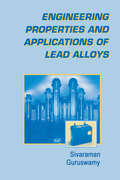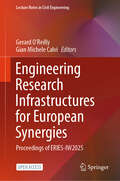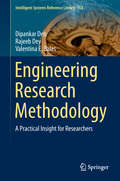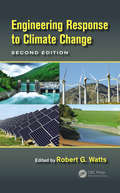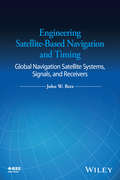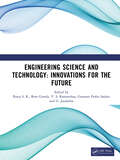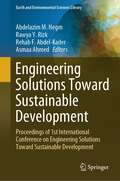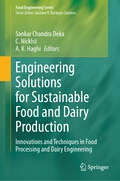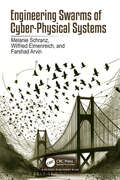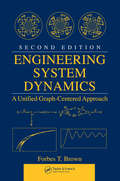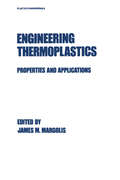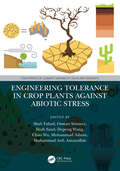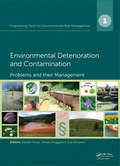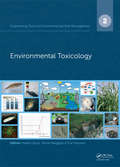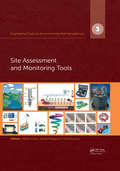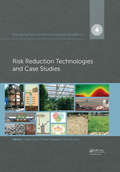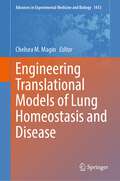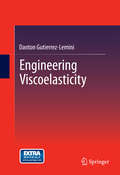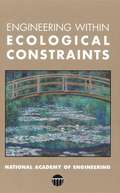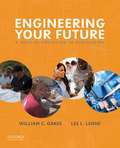- Table View
- List View
Engineering Properties and Applications of Lead Alloys
by Sivaraman GuruswamyFocusing on the uses of lead in pure or alloy form for engineering applications, this text presents data on the physical, mechanical, corrosive, accoustic, damping and nuclear properties of lead and lead alloys. It organizes information according to alloy type in tables, graphs and text, and examines the processing of commercially available lead pr
Engineering Research Infrastructures for European Synergies: Proceedings of ERIES-IW2025 (Lecture Notes in Civil Engineering #718)
by Gian Michele Calvi Gerard J. O’ReillyThis open access book highlights the latest advances, innovations, and applications in the field of earthquake engineering, as presented by leading international researchers and engineers at the International Workshop in Engineering Research Infrastructures for European Synergies (ERIES-IW), held in Lisbon, Portugal, on May 7–9, 2025. The event was meant to provide a unique platform to exchange experiences, share results, and explore future directions in seismic, wind, and geotechnical engineering research, with a focus on reducing hazard-related losses, managing risk, and fostering sustainable solutions. The contributions, which were selected by means of a rigorous international peer-review process, present a wealth of exciting ideas that will open novel research directions and foster multidisciplinary collaboration among different specialists.
Engineering Research Methodology: A Practical Insight For Researchers (Intelligent Systems Reference Library #153)
by Rajeeb Dey Valentina E. Balas Dipankar DebThe book covers all the important aspects of research methodology, and addresses the specific requirements of engineering students, such as methods and tools, in detail. It also discusses effective research in engineering today, which requires the ability to undertake literature reviews utilizing different online databases, to attribute credit for any prior work mentioned, to respect intellectual property rights while simultaneously maintaining ethics in research, and much more. Further, the book also considers soft skills like research management and planning, dealing with criticism in research and presentation skills, which are all equally important and need to include in research methodology education. Lastly, it provides the technical knowhow needed to file patents in academia, an important area that is often ignored in research methodology books. The book is a particularly valuable resource for PhD students in India and South East Asia, as research methodology is a part of their coursework.
Engineering Response to Climate Change
by Robert G. WattsA clear, concise discussion of today's hottest topics in climate change, including adapting to climate change and geo-engineering to mitigate the effects of change, Engineering Response to Climate Change, Second Edition takes on the tough questions of what to do and offers real solutions to the practical problems caused by radical changes in the Ea
Engineering Rules: Global Standard Setting since 1880 (Hagley Library Studies in Business, Technology, and Politics)
by JoAnne Yates Craig N. MurphyThe first global history of voluntary consensus standard setting.Finalist, Hagley Prize in Business History, The Hagley Museum and Library / The Business History ConferencePrivate, voluntary standards shape almost everything we use, from screw threads to shipping containers to e-readers. They have been critical to every major change in the world economy for more than a century, including the rise of global manufacturing and the ubiquity of the internet. In Engineering Rules, JoAnne Yates and Craig N. Murphy trace the standard-setting system's evolution through time, revealing a process with an astonishingly pervasive, if rarely noticed, impact on all of our lives. This type of standard setting was established in the 1880s, when engineers aimed to prove their status as professionals by creating useful standards that would be widely adopted by manufacturers while satisfying corporate customers. Yates and Murphy explain how these engineers' processes provided a timely way to set desirable standards that would have taken much longer to emerge from the market and that governments were rarely willing to set. By the 1920s, the standardizers began to think of themselves as critical to global prosperity and world peace. After World War II, standardizers transcended Cold War divisions to create standards that made the global economy possible. Finally, Yates and Murphy reveal how, since 1990, a new generation of standardizers has focused on supporting the internet and web while applying the same standard-setting process to regulate the potential social and environmental harms of the increasingly global economy.Drawing on archival materials from three continents, Yates and Murphy describe the positive ideals that sparked the standardization movement, the ways its leaders tried to realize those ideals, and the challenges the movement faces today. Engineering Rules is a riveting global history of the people, processes, and organizations that created and maintain this nearly invisible infrastructure of today's economy, which is just as important as the state or the global market.
Engineering Satellite-Based Navigation and Timing
by John W. BetzThis book describes the design and performance analysis of satnav systems, signals, and receivers, with a general approach that applies to all satnav systems and signals in use or under development. It also provides succinct descriptions and comparisons of each satnav system. Clearly structured, and comprehensive depiction of engineering satellite-based navigation and timing systems, signals, and receivers GPS as well as all new and modernized systems (SBAS, GLONASS, Galileo, BeiDou, QZSS, IRNSS) and signals being developed and fielded Theoretical and applied review questions, which can be used for homework or to obtain deeper insights into the material Extensive equations describing techniques and their performance, illustrated by MATLAB plots New results, novel insights, and innovative descriptions for key approaches and results in systems engineering and receiver design If you are an instructor and adopted this book for your course, please email ieeeproposals@wiley.com to get access to the instructor files for this book.
Engineering Science and Technology: Innovations for the Future
by S. R. Reeja Bore Gowda Y. S. Rammohan Ganesan Prabu Sankar G. JayalathaThe International Conference on Recent Innovations in Engineering Science & Technology (ICRIET-2025), hosted by KSIT Bengaluru, brought together researchers and experts from around the world to present 225 peer reviewed papers across four engineering domains. With keynote sessions on AI, energy harvesting, and sustainable manufacturing, the conference promoted interdisciplinary dialogue and cutting-edge innovation. It served as a dynamic platform for academic exchange, fostering collaboration between academia and industry. ICRIET-2025 stands as a testament to KSIT’s commitment to advancing research and technological progress.
Engineering Solid Mechanics: Fundamentals and Applications
by Abdel-Rahman A. Ragab Salah Eldin BayoumiEngineering Solid Mechanics bridges the gap between elementary approaches to strength of materials and more advanced, specialized versions on the subject.The book provides a basic understanding of the fundamentals of elasticity and plasticity, applies these fundamentals to solve analytically a spectrum of engineering problems, and introduces advanced topics of mechanics of materials - including fracture mechanics, creep, superplasticity, fiber reinforced composites, powder compacts, and porous solids.Text includes:stress and strain, equilibrium, and compatibilityelastic stress-strain relationsthe elastic problem and the stress function approach to solving plane elastic problemsapplications of the stress function solution in Cartesian and polar coordinatesProblems of elastic rods, plates, and shells through formulating a strain compatibility function as well as applying energy methodsElastic and elastic-plastic fracture mechanicsPlastic and creep deformationInelastic deformation and its applications This book presents the material in an instructive manner, suitable for individual self-study. It emphasizes analytical treatment of the subject, which is essential for handling modern numerical methods as well as assessing and creating software packages. The authors provide generous explanations, systematic derivations, and detailed discussions, supplemented by a vast variety of problems and solved examples.Primarily written for professionals and students in mechanical engineering, Engineering Solid Mechanics also serves persons in other fields of engineering, such as aerospace, civil, and material engineering.
Engineering Solutions Toward Sustainable Development: Proceedings of 1st International Conference on Engineering Solutions Toward Sustainable Development (Earth and Environmental Sciences Library)
by Abdelazim M. Negm Rawya Y. Rizk Rehab F. Abdel-Kader Asmaa AhmedThis book constitutes the referred proceeding of the 1st International Conference on Engineering Solutions Toward Sustainable development (ESSD2023), organized by the Faculty of Engineering, Port Said University and held in Port Said, Egypt, during May 2-3, 2023. The book is devoted to fulfill the need for sustainable development that has never been more urgent. It shows the crucial role of engineering to play in this transition from consumption culture to responsible culture. This book explores the relationship between engineering and sustainability, highlighting the vital role that engineering plays in achieving sustainable development. The book provides a comprehensive guide for engineers, researchers, and experts from different disciplines that are interested in sustainable development. From renewable energy sources to green infrastructure, the book delves into the latest technological advancements providing insights and practical strategies for designing and implementing sustainable solutions. With practical examples and case studies, readers will gain a deep understanding of how engineering principles and practices can be harnessed to develop sustainable solutions that balance economic, social, and environmental needs and to mitigate the negative impacts of human activity on our planet. The books is very useful for graduate students, researchers, policy planners, decision makers and stakeholders in the field of renewable energy, clean water development, climate actions, smart cities and communities and green infrastructures.
Engineering Solutions for Sustainable Food and Dairy Production: Innovations and Techniques in Food Processing and Dairy Engineering (Food Engineering Series)
by A. K. Haghi Sankar Chandra Deka C. NickhilThis book offers a comprehensive exploration of food and dairy process engineering, catering to a diverse audience ranging from students and budding engineers to seasoned professionals in the food industry. It delves into a wide array of crucial topics, each meticulously crafted to provide valuable insights into the complex world of food and dairy processing. Engineering Solutions for Sustainable Food and Dairy Production begins by addressing the paramount concern of safety in the food industry, tackling challenges and opportunities in ensuring the quality and integrity of food products. The book promotes an understanding of the sources of dairy products and the practices involved in dairy farming, which are pivotal for producing high-quality dairy goods. Raw material management and quality control techniques are covered in full, as are fluid mechanics and heat transfer and pasteurization techniques. Fermentation processes are explored in-depth, showcasing their significance in the creation of various food products. Separation technologies such as filtration and centrifugation techniques are studied and evaporation and concentration techniques are discussed which enables the production of condensed and powdered items. A full chapter is dedicated to food and dairy freezing and cooling techniques, focusing on maintaining the correct temperature and various freezing and cooling methods. For researchers in search of the most updated technologies and techniques for sustainable food and dairy processing, this text functions as a singular source
Engineering Statics
by M. Rashad Islam M. Abdullah Al Faruque Bahar Zoghi Sylvester A. KalevelaEngineering Statics presents the cutting-edge topics in engineering statics, focusing on practical applications knowledge, with numerous real-world examples, practice problems, and case studies throughout. It covers theory concisely and uses plain language and coverage that can be completed in a one-semester course. It also covers the related concepts required to take the Fundamentals of Engineering (FE) exam. Features: Written in plain language, with numerous realistic step-by-step examples. Covers topics required to understand and prepare for the Fundamentals of Engineering (FE) exam. Includes practical case studies, concise theory and numerous solved practice problems. Engineering Statics is suitable for undergraduate students in civil and mechanical engineering courses, as well as those in Engineering Technology and Applied courses. This book includes material suitable for first and second-year undergraduate courses, as well as more senior students. The authors believe that this text will be very helpful for students to succeed in their degree programs and professional careers.
Engineering Swarms of Cyber-Physical Systems
by Wilfried Elmenreich Farshad Arvin Melanie SchranzEngineering Swarms for Cyber-Physical Systems covers the whole design cycle for applying swarm intelligence in Cyber-Physical Systems (CPS) and guides readers through modeling, design, simulation, and final deployment of swarm systems. The book provides a one-stop-shop covering all relevant aspects for engineering swarm systems. Following a concise introduction part on swarm intelligence and the potential of swarm systems, the book explains modeling methods for swarm systems embodied in the interplay of physical swarm agents. Examples from several domains including robotics, manufacturing, and search and rescue applications are given. In addition, swarm robotics is further covered by an analysis of available platforms, computation models and applications. It also treats design methods for cyber-physical swarm applications including swarm modeling approaches for CPSs and classical implementations of behaviors as well as approaches based on machine-learning. A chapter on simulation covers simulation requirements and addresses the dichotomy between abstract and detailed physical simulation models. A special feature of the chapters is the hands-on character by providing programming examples with the different engineering aspects whenever possible, thus allowing for fast translation of concepts to actual implementation. Overall, the book is meant to give a creative researcher or engineer the inspiration, theoretical background, and practical knowledge to build swarm systems of CPSs. It also serves as a text for students in science and engineering.
Engineering System Dynamics: A Unified Graph-Centered Approach, Second Edition
by Forbes T. BrownFor today's students, learning to model the dynamics of complex systems is increasingly important across nearly all engineering disciplines. First published in 2001, Forbes T. Brown's Engineering System Dynamics: A Unified Graph-Centered Approach introduced students to a unique and highly successful approach to modeling system dynamics using bond g
Engineering Tennis
by Cricket MediaSports engineering analyzes a player's moves and the equipment. One challenge was the "spaghetti racquet", which caused an uproar in the tennis world.
Engineering Thermoplastics: Properties and Applications
by James M. MargolisThis book provides solutions to many vital questions on the important property differences and advantages of individual engineering thermoplastics. It is useful for executives; managers; design, materials, and sales engineers; researchers; materials and product manufacturers; and compounders.
Engineering Tolerance in Crop Plants Against Abiotic Stress (Footprints of Climate Variability on Plant Diversity)
by Shah FahadDespite significant progress in increasing agricultural production, meeting the changing dietary preferences and increasing food demands of future populations remains a significant challenge. Salinity, drought, water logging, high temperature and toxicity are abiotic stresses that affect the crop yield and production. Tolerance for stress is a important characteristic that plants need to have in order to survive. Identification of proper techniques at a proper time can make it easy for scientists to increase crop productivity and yield. In Engineering Tolerance in Crop Plants against Abiotic Stress we have discussed the possible stresses and their impact on crops and portrayed distinctive abiotic stress tolerance in response to different techniques that can improve the performance of crops. Features of the Book: Provide a state-of-the-art description of the physiological, biochemical, and molecular status of the understanding of abiotic stress in plants. Address factors that threaten future food production and provide potential solution to these factors. Designed to cater to the needs of the students engaged in the field of environmental sciences, soil sciences, agricultural microbiology, plant pathology, and agronomy. New strategies for better crop productivity and yield. Understanding new techniques pointed out in this book will open the possibility of genetic engineering in crop plants with the concomitant improved stress tolerance.
Engineering Tools for Environmental Risk Management: 1. Environmental Deterioration and Contamination - Problems and their Management (Engineering Tools for Environmental Risk Management)
by John R. Wilson Sarah SharplesThis is the first volume of the five-volume book seriesEngineering Tools for Environmental Risk Management dealing with the following topics: types and management of environmental deterioration, particularly pollution; environmental toxicology as a versatile tool in monitoring and risk management; risk assessment of chemical substances and c
Engineering Tools for Environmental Risk Management: 2. Environmental Toxicology (Engineering Tools for Environmental Risk Management)
by Katalin Gruiz Tamás Meggyes Éva FenyvesiChemical substances, physical agents and built structures exhibit various types of hazard due to their inherent toxic, mutagenic, carcinogenic, reprotoxic and sensitizing character or damaging to the immune and hormone system. The first steps in managing an environment contaminated by chemical substances are characterization of hazards and quantifi
Engineering Tools for Environmental Risk Management: 3. Site Assessment and Monitoring Tools (Engineering Tools for Environmental Risk Management #3)
by Katalin Gruiz Éva Fenyvesi TamásThis is the third volume of the five-volume book series “Engineering Tools for Environmental Risk Management”. The book series deals with the following topics: • Environmental deterioration and pollution, management of environmental problems• Environmental toxicology – a tool for managing chemical substances and contaminated environment• Assessment and monitoring tools, risk assessment• Risk reduction measures and technologies• Case studies for demonstration of the application of engineering tools The authors aim to describe interactions and options in risk management by providing a broad scientific overview of the environment, its human uses and the associated local, regional and global environmental problems; interpreting the holistic approach used in solving environmental protection issues; striking a balance between nature’s needs and engineering capabilities; understanding interactions between regulation, management and engineering; obtaining information about novel technologies and innovative engineering tools. This third volume provides an overview on the basic principles, concepts, practices and tools of environmental monitoring and contaminated site assessment. The volume focuses on those engineering tools that enable integrated site assessment and decision making and ensure an efficient control of the environment. Some topics supporting sustainable land use and efficient environmental management are listed below: • Efficient management and regulation of contaminated land and the environment;• Early warning and environmental monitoring;• Assessment of contaminated land: the best practices;• Environmental sampling;• Risk characterization and contaminated matrix assessment;• Integrated application of physical, chemical, biological, ecological and (eco) toxicological characterization methods;• Direct toxicity assessment (DTA) and decision making;• Online analyzers, electrodes and biosensors for assessment and monitoring of waters.;• In situ and real-time measurement tools for soil and contaminated sites;• Rapid on-site methods and contaminant and toxicity assessment kits;• Engineering tools from omics technologies, microsensors to heavy machinery;• Dynamic characterization of subsurface soil and groundwater using membrane interface probes, optical and X-ray fl uorescence and ELCAD wastewater characterization;• Geochemical modeling: methods and applications;• Environmental assessment using cyclodextrins. This book series focuses on the state of knowledge about the environment and its conscious and structured application in environmental engineering, management and decision making.
Engineering Tools for Environmental Risk Management: 4. Risk Reduction Technologies and Case Studies (Engineering Tools for Environmental Risk Management #4)
by Katalin Gruiz Tamás Meggyes Éva FenyvesiThe four volumes of the book series "Engineering Tools for Environmental Risk Management" deal with environmental management, assessment & monitoring tools, environmental toxicology and risk reduction technologies. This last volume focuses on engineering solutions usually needed for industrial contaminated sites, where nature’s self-remediation is inefficient or too slow. The success of remediation depends on the selection of an increasing number of conventional and innovative methods. This volume classifies the remedial technologies and describes the reactor approach to understand and manage in situ technologies similarly to reactor-based technologies. Technology types include physicochemical, biological or ecological solutions, where near-natural, sustainable remediation has priority. <P><P>A special chapter is devoted to natural attenuation, where natural changes can help achieve clean-up objectives. Natural attenuation and biological and ecological remediation establish a serial range of technologies from monitoring only to fully controlled interventions, using ‘ just’ the natural ecosystem or sophisticated artificial living systems. Passive artificial ecosystems and biodegradation-based remediation – in addition to natural attenuation – demonstrate the use of these ‘green’ technologies and how engineering intervention should be kept at a minimum to limit damage to the environment and create a harmonious ecosystem. <P><P>Remediation of sites contaminated with organic substances is analyzed in detail including biological and physicochemical methods. Comprehensive management of pollution by inorganic contaminants from the mining industry, leaching and bioleaching and acid mine drainage is studied in general and specifically in the case of an abandoned mine in Hungary where the innovative technology of combined chemical and phytostabilization has been applied. <P><P>The series of technologies is completed by electrochemical remediation and nanotechnologies. Monitoring, verification and sustainability analysis of remediation provide a comprehensive overview of the management aspect of environmental risk reduction by remediation. This book series focuses on the state of knowledge about the environment and its conscious and structured application in environmental engineering, management and decision making.
Engineering Translational Models of Lung Homeostasis and Disease (Advances in Experimental Medicine and Biology #1413)
by Chelsea M. MaginCutting-edge engineering approaches towards modelling lung homeostasis and disease have created dynamic new opportunities for interdisciplinary collaboration and unprecedented progress toward understanding and treating lung disease. This text connects established research in lung biology and physiology to innovative engineering strategies for pulmonary modelling. This unique approach aims to encourage and facilitate progress among a greater audience of basic and translational scientists, clinicians, and medical practitioners. Engineering Translational Models of Lung Homeostasis and Disease illustrates the advances in lung tissue characterization, revealing dynamic changes in the structure, mechanics, and composition of the extracellular matrix. This information paves the way for tissue-informed engineering models of pulmonary tissue, improved design of clinical materials, and advances against a variety of common pathologies. Current translational challenges are highlighted, as are engineering opportunities to overcome these barriers. This foundational text holds valuable lessons for researchers and clinicians throughout the fields of engineering, materials science, cell biology, pulmonary medicine, and clinical science.· Each section focuses on a specific region of the lung, presenting either the biological or clinical perspective along with complimentary engineering approaches · Covers the interface of engineering and lung biology · Highlights emerging new models to study lung disease and repair
Engineering Victory: How Technology Won the Civil War (Johns Hopkins Studies in the History of Technology)
by Thomas F. Army Jr.Superior engineering skills among Union soldiers helped ensure victory in the Civil War.Engineering Victory brings a fresh approach to the question of why the North prevailed in the Civil War. Historian Thomas F. Army, Jr., identifies strength in engineering—not superior military strategy or industrial advantage—as the critical determining factor in the war’s outcome.Army finds that Union soldiers were able to apply scientific ingenuity and innovation to complex problems in a way that Confederate soldiers simply could not match. Skilled Free State engineers who were trained during the antebellum period benefited from basic educational reforms, the spread of informal educational practices, and a culture that encouraged learning and innovation. During the war, their rapid construction and repair of roads, railways, and bridges allowed Northern troops to pass quickly through the forbidding terrain of the South as retreating and maneuvering Confederates struggled to cut supply lines and stop the Yankees from pressing any advantage.By presenting detailed case studies from both theaters of the war, Army clearly demonstrates how the soldiers’ education, training, and talents spelled the difference between success and failure, victory and defeat. He also reveals massive logistical operations as critical in determining the war’s outcome.
Engineering Viscoelasticity
by Danton Gutierrez-LeminiEngineering Viscoelasticity covers all aspects of the thermo- mechanical response of viscoelastic substances that a practitioner in the field of viscoelasticity would need to design experiments, interpret test data, develop stress-strain models, perform stress analyses, design structural components, and carry out research work. The material in each chapter is developed from the elementary to the esoteric, providing the background in mathematics and mechanics that are central to understanding the subject matter being presented. This book also examines how viscoelastic materials respond to the application of loads, and provides practical guidelines to use them in the design of commercial, military and industrial applications.
Engineering Within Ecological Constraints
by National Academy of Engineering Staff Peter SchulzeEngineering within Ecological Constraints presents a rare dialogue between engineers and environmental scientists as they consider the many technical as well as social and legal challenges of ecologically sensitive engineering. The volume looks at the concepts of scale, resilience, and chaos as they apply to the points where the ecological life support system of nature interacts with the technological life support system created by humankind.Among the questions addressed are: What are the implications of differences between ecological and engineering concepts of efficiency and stability? How can engineering solutions to immediate problems be made compatible with long-term ecological concerns? How can we transfer ecological principles to economic systems?The book also includes important case studies on such topics as water management in southern Florida and California and oil exploration in rain forests.From its conceptual discussions to the practical experience reflected in case studies, this volume will be important to policymakers, practitioners, researchers, educators, and students in the fields of engineering, environmental science, and environmental policy.
Engineering Your Future: A Brief Introduction To Engineering (Sixth Edition)
by William C. Oakes Les L. Leone Toby Cumberbatch Heidi Diefes-Dux John Dilworth Ralph Flori Craig Gunn Todd Robert Hamrick Daniel HartnerEngineering Your Future is an authoritative guide to the academic expectations and professional opportunities in engineering, a field that is both academically rigorous and creatively demanding. Today's engineering students are faced with endless career opportunities. This text clarifies thoseoptions and directs students down the path to a rewarding career in the engineering field. This concise and inexpensive version of the comprehensive edition contains the eleven most popular chapters from its parent text, offering the best option for instructors looking for a solid base from which to work while they incorporate outside projects or assignments.
